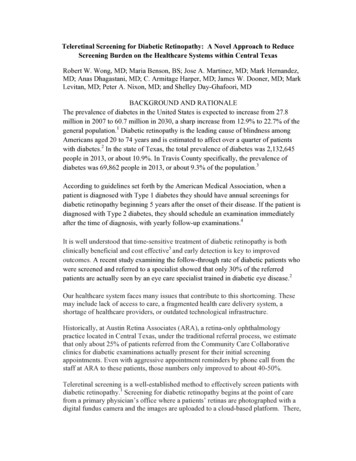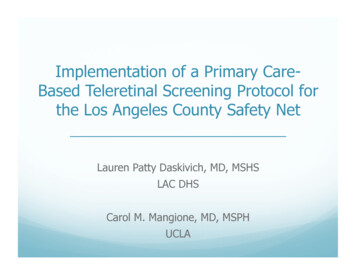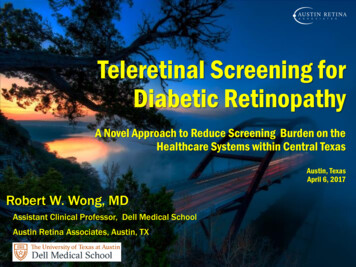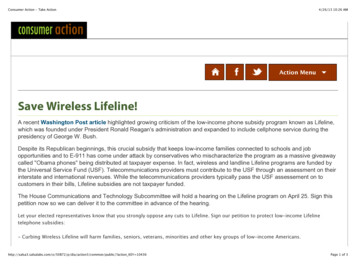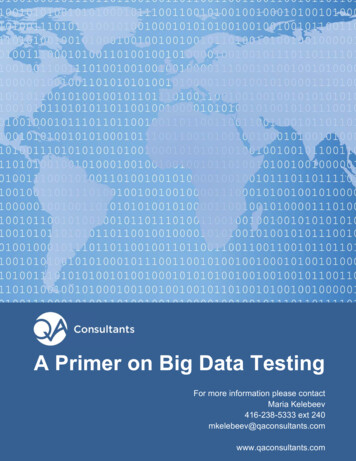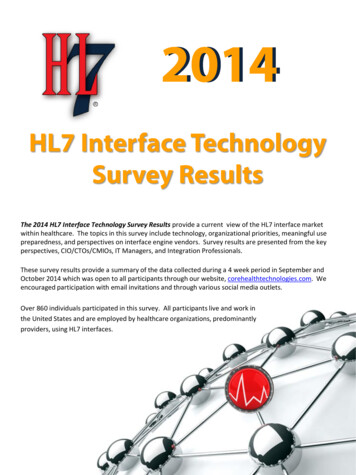
Transcription
TeleretinalAction Guide(Prepared by CHV/NACHC ClinicalAffairs Division)Supported by Welch Allyn
DIABETIC RETINOPATHY IS THE MOSTCOMMON CAUSE OF VISION IMPAIRMENTAND BLINDNESS AMONG WORKING-AGEADULTS IN THE UNITED STATES.2NACHC.orgRetinaVue.com
WHY ADDRESS DIABETES CONTROL ANDDIABETIC RETINAL EXAMS IN HEALTH CENTERS?In 2017, Community Health Centers, with over11,500 service sites, provided care for morethan 27 million people. 2.3 million patients haddiabetes (ages 18-75) and 32.95% were consideredout of control (Hba1c 9%)1. Given that health centersprovide primary care to one out of twelve Americans,it is important that they practice early identificationand effective treatment of patients with diabetes tobring about glycemic control. Through early diagnosisand aggressive treatment regimens, health centerscan help to decrease the incidence of one of themost debilitating sequelae of uncontrolled diabetes:diabetic retinopathy (DR), which affects both type 1and type 2 diabetic patients and places them at riskfor vision impairment or blindness.According to the Centers for Disease Control andPrevention (CDC), DR is the most common cause ofvision impairment and blindness among working-ageadults in the United States. From 2010 to 2050, thenumber of Americans with DR is expected to nearlydouble, from 7.7 million to 14.6 million. DR occurswhen diabetes, through both the duration of thedisease and level of control, affects the blood vesselsin the retina. If not found and treated early, DR cancause permanent vision loss.2Undiagnosed conditions can lead to preventablecomplications, including: Blindness from diabetes Glaucoma Other diseasesProviding diabetic retinal exams in the primary caresetting can effectively detect sight-threatening DR.3This is especially important for health centers, as thepopulations they serve often have socioeconomicfactors that may limit access to eye care specialtyclinicians and the services they provide.4 For healthcenters, taking action in this critical aspect of carefor diabetic populations is of utmost importance, asthe vision and well-being of millions of people are atstake.Although early detection and treatment of sightthreatening DR can prevent blinding complications,less than half of all people with diabetes receiverecommended yearly eye examinations. Whileprimary health care providers have traditionallyreferred their patients to eye care providers forannual diabetic retina exams, patients often fail tovisit because of: Geographic barriers Social barriers Economic barriers Other barriers3NACHC.orgA GLOBAL EPIDEMICThere are approximately 425 millionpeople in the world living with diabetes.By 2045, this number is projected to growto 629 million.RetinaVue.com
WHAT DOES A TELERETINAL CARE DELIVERYMODEL LOOK LIKE IN PRIMARY CARE ANDHEALTH CENTER SETTINGS?Primary Care SettingThe Agency for Healthcare Research and Quality’s (AHRQ) Health Care Innovations Exchangehas several examples of teleretinal care delivery models that successfully facilitated diagnosisand treatment of DR for poor and/or uninsured patients with diabetes. During a two-year studyconducted by the University of California Berkeley School of Optometry, diabetic retinal exams wereprovided to more than 1,200 patients in California’s Central Valley, an area where many residents arepoor and uninsured and might not ordinarily have access to this type of specialty care.Study highlights include: Over 120,000 consults performed in 194 active clinic sites Significant compliance with diabetic retinal exams Retinopathy identified in one-half of patients 15% of all patients referred for follow-up care5This study received an AHRQ “Moderate” rating, meaning no randomized or controlled experimentswere conducted, yet the results show the effectiveness of a teleretinal care delivery model.Key operational aspects of implementing such a program in the primary care setting aredocumented in the Diabetic Retinopathy Screening Practice Guide, an outcome of the study.#1Diabetic retinopathy is thenumber one cause of blindnessamong working-age adults.Diabetic retinopathy occurs when high bloodsugar levels damage tiny blood vessels in theretina causing them to leak or hemorrhage,ultimately distorting vision once progressed tosevere levels.4NACHC.orgRetinaVue.com
Typical Teleretinal Workflow:5Patient identified with no DR exam in past 12 monthsPatient referred for teleretinalexamImages captured underdirection of a physicianImages interpretedDiagnostic report returned to physicianResults communicated to patientThere are a variety of ways to administerteleretinal exams for diabetic patientsincluding appointments in primary care,community events and mobile exams.5NACHC.orgRetinaVue.com
Health Center SettingCommunity Health Center, Inc.A study of the annual comprehensive exam process for patients with diabetes at Community HealthCenter, Inc. (CHC, Inc.) in Connecticut, was highlighted in AHQR’s Health Care Innovations Exchange.The CHC, Inc. model includes: Retinal imaging equipment Trained medical assistants who capture and electronically transmit digital retinal images toophthalmology specialists at the Yale Eye Center Remote ophthalmologists who are paid a flat fee per reading offer follow-up care remotely andin person to patients unable to access care locallyThe program improved access to diabetic retinal exams, reduced costs, and increased patientconvenience and satisfaction.7 This study received an AHRQ “Moderate” rating.EARLY DETECTION IS KEY50 - 60%95% of vision loss cases are preventable withearly detection and treatment.All diabetic patients should receive an annualdiabetic retinal exam with an ophthalmologistor optometrist.Only about half of patients with diabetes visitthe eye specialist for annual retinal exams.6NACHC.orgRetinaVue.com
Cherokee Health SystemsCherokee Health Systems (CHS), a health center with corporate offices in Knoxville,Tennessee, developed a teleretinal program utilizing the Welch Allyn RetinaVue caredelivery model. In 2018, nine CHS sites provided almost 1,300 diabetic retinal examswith RetinaVue, and had the following results: 93% readable image rate Identified 99 patients with age-related macular degeneration or AMD/glaucoma(8%) Diagnosed 70 patients with not-sight-threatening DR (5%) Diagnosed and referred 49 patients with sight-threatening DR (4%)CHS believes that without the RetinaVue care delivery model, 218 patients (17%)would have probably gone undiagnosed and risked permanent visual impairmentor blindness. And, the RetinaVue care delivery model as implemented at CHS isfinancially sustainable.Cherokee Health Systems has done extensive work over the past several years tooperationalize the use of RetinaVue care delivery model in its health center sites. Keyoperational tools in its program include (Exhibits 1-4, see page 15):1.Diabetic eye exam workflow2. Competency check for retinal photographers3. Pupil dilation protocol4. Welch Allyn RetinaVue Network software EMR Connectivity with NextGenThese documents and electronic health record processes are easily adoptable in anyprimary care or health center plan for the implementation of a teleretinal programusing RetinaVue care delivery model.7NACHC.orgRetinaVue.com
HOW TO IMPLEMENT A TELERETINAL PROGRAMSteps:1.Assess incidence of diabetes and need for diabetic retinal exam2.Convene administrative and clinical leadership to assess adoption3.Develop a business plan to implement and sustain a teleretinal program4.Arrange on-site or remote eye specialist support5.Set up clinical and financial IT systems to monitor and track outcomes6.Initiate operational implementation plan7.Assure payment/reimbursement for servicesStep 1: Assess incidence of diabetes and need for diabetic retinal examsAssessing the incidence of diabetes in a particular region or health center service area is thebest starting point for a teleretinal program. The rate of poor diabetic control (Hba1c 9%) willdetermine the need for diabetic retinal exams and can be accessed in the latest Uniform DataSystem (UDS) reports. To begin, follow the steps below:1.Go to the latest UDS report portal found at https://bphc.hrsa.gov/uds/datacenter.aspx2. Click on “View National, State and Program Grantee Data.”Enter your state and select your health center.3. Click on “Clinical Data” to see the percentage of patientswith diabetes and trends over the past three years for yourhealth center.4. Scroll down the page and identify the percentage ofpatients with poor control or no testing for their diabetes.5. Calculate the number of patients in these two categories(diagnosis with diabetes and with poor control) bymultiplying total patients served by the percentages noted.6. Click on “Related” links to compare your health center to allhealth center grantees in your state or on a national level.These numbers will provide an estimate of the impact diabetesis having in the communities you serve. Keep in mind that thelonger a person has diabetes, especially with uncontrolled HbA1c ( 9%), the greater the chanceof complications, including diabetic retinopathy, visual impairment, and blindness.8NACHC.orgRetinaVue.com
Step 2: Convene administrative and clinical leadership to assess adoptionAssessing the costs and benefits of a teleretinal program is essential. Convening a meeting ofhealth center leadership, both administrative and clinical, will determine commitment levels. Somethings to consider: Be objective: Use the calculations from the prior step to compare your health center’s diabeticpopulation to those in your state or nationally. If your patient panel is at or well above thestate or national average, your team may decide it is important enough to initiate a teleretinalprogram. Consider the risk to a single patient: Some health center leadership teams have decided thatfor any population or number of patients with diabetes, it is worth their investment to preventa large percentage (17 percent in the CHS example above) of their patients from developingimpaired vision or blindness. Can it pay for itself: Others evaluate the numbers in terms of reimbursement (depending upontheir payer mix and reimbursement mechanisms) and decide whether they would have a volumehigh enough to cover the costs for equipment, staff time, and eye specialist fees. Walk before you run: If the answer to adoption is yes, you may want to pilot the teleretinalprogram at a manageable number of sites to start. Measure costs, revenue, compliance rateswith DR exams, and follow-up monitoring and treatment by eye specialists. Then optimizeprocess and workflow and expand the program to additional sites when appropriate.80%of patientsWHO IS AT RISK?80% of diabetic patients, type 1 and type 2,will eventually develop some stage of diabeticretinopathy.The longer a person has diabetes, the more likelythey are to develop diabetic retinopathy.9NACHC.orgRetinaVue.com
Step 3: Develop a business plan to implement and sustain a teleretinal programKnowing the costs incurred by your healthcenter related to specific services andcompared to reimbursement levels iscritical to your organization’s overall health.This is especially true when introducing anew service and any review should alwaysinclude a break-even or positive marginreimbursement analysis of: Payer-specific reimbursement under: Medicaid Medicare Commercial insurance Chronic Care Management (CCM)fees Sliding fee co-pays Outside grant/foundation fundingSome things to consider:Reading retinal images: Using on-sitepersonnel to interpret and diagnose retinalimages can be a cost savings if you have eyespecialists or certified ophthalmic readerson staff. Alternatively, there are many localor remote eye specialists who will costeffectively interpret retinal images andprovide a diagnosis and report.In the case of Cherokee Health Services,they noted: Average cost for a teleretinal examinationwas about 50.00 per patient A traditional in-person exam cost 77.80 Using CPT code 92250 (FundusPhotography with Interpretation andReport) CHS charges 123.00 per visit Reimbursement from insurancecompanies ranges from 37.68 to 77.26per examSliding fee: For their sliding fee patients,co-pays for Community Health Center, Inc.(CHC, Inc.) and Cherokee Health Services(CHS) range from 20.00 to 40.00depending upon annual income and familysize.These figures are starting points forcomparison and each organization needsto perform a full financial assessment todetermine the exact charges/reimbursementto seek for exams.Both CHC, Inc. and CHS found that thesereimbursement models sustained theteleretinal program for their facilities.KNOWING THE COSTS INCURRED BY YOURHEALTH CENTER RELATED TO SPECIFICSERVICES AND COMPARED TO REIMBURSEMENTLEVELS IS CRITICAL TO YOUR ORGANIZATION’SFINANCIAL HEALTH.10 NACHC.orgRetinaVue.com
Step 4: Arrange on-site or remote eye specialist supportAccording to the 2017 UDS report, almost340 health centers have ophthalmology/optometry professionals on staff (about 25% ofall health centers). If your health center is oneof those fortunate facilities, the reading andinterpretation of retinal images might be doneusing your own staff. If your facility does notprovide these services, other options include: Initiating relationships with an academicmedical center that provides retinal imagereading services or local eye specialists whomay want to participate in your teleretinalprogram Contracting with national medical serviceproviders such as RetinaVue, P.C., the firsttele-ophthalmology provider to receiveambulatory care accreditation through TheJoint CommissionOther things to consider:Rural dilemma:Utilizing internet-based retinal image readingservices might be the only option dependingupon your geographic location (rural, frontier, orremote locations).Set a fee schedule that works for you:Once identified, establish a payment schedule(monthly, quarterly, etc.) that makes sensefor your volume of exams, reimbursementmechanisms, and payer mix.Step 5: Set up clinical and financial IT systems to monitor and track outcomesOnly when an organization accurately andregularly monitors clinical and financialinformation related to teleretinal programsin EHR and Practice Management Systemswill it keep on track (process measures) andassure desired outcomes (outcome measures).Examples of process measures include: The percentage of patients with thediagnosis of diabetes who receive an annualretinal exam The percentage of patients who keep theirdiabetic eye appointments The percentage of patients who follow upafter being referred to an eye specialist Collection rates for co-pays11NACHC.org Denial rates for insurance billing Actual break-even analysis for the teleretinalprogram overallClinical outcome measures might includethe number of patients for whom age-relatedmacular degeneration/glaucoma, DR, andsight-threatening DR have been identified andreferred.Knowing where your health center standsat all times relative to both process measuresand outcome measures is necessary to monitorprogress or maintain performance levels.This is especially important in value-basedreimbursement systems.RetinaVue.com
Step 6: Initiate operational implementation planInitiate the teleretinal program through theconcurrent purchase of RetinaVue retinalcameras, staff training, and EHR order entry andreport reception mapping.Having moved through the previous five stepsand utilized the tools provided in Exhibits1-4, a health center will have taken concretesteps towards operational implementation of ateleretinal program. Some things to consider:Create a patient process map: Be sure toinclude each step a patient might take prior to,during, and after their visit for a diabetic retinalexam. Couple the patient process map with anequivalent staff-focused version that helpsto develop a well-balanced approach andavoids missteps or work duplication.Be keen users of EHR populationmanagement software functions.Utilizing the EHR and Practice ManagementSystem can help: Identify patients who need a diabetic retinalexam or re-imaging Make and complete orders for appointments Follow up on referrals, consultant reporting,and communications with patients regardingresultsPopulation management software can alsoassist in: Generating reports to assess compliancewith annual diabetic retinal exams Tracking patient follow up with the eyespecialist and diagnostic outcomes Comparing all metrics to network, state, ornational measuresStep 7: Assure payment/reimbursement for servicesTracking, monitoring, and improving accuracy and timeliness for payment/reimbursement is keyto implementing and sustaining a teleretinal program. Only by such close and accurate reportingwill an organization be able to assure financial viability and use these mechanisms to identifyinadequate coding, poor documentation, delayed claim submissions, and receipt of payment.Billing, coding, and submitting accurately for payment are the bedrock for financial stability.Maintaining high performance in this area requires ongoing monitoring and updating of processeswhen inefficiencies or problems are identified.Once an organization is at the break-even or positive margin point, it can begin to consider scaleand spread of these services within sites and in other locations.12NACHC.orgRetinaVue.com
TRACKING, MONITORING, AND IMPROVING ACCURACYAND TIMELINESS FOR PAYMENT/REIMBURSEMENTIS KEY TO IMPLEMENTING AND SUSTAINING ATELERETINAL PROGRAM.13NACHC.orgRetinaVue.com
THE VALUE IN IMPLEMENTING ADIABETIC TELERETINAL PROGRAMHealth Centers play a key role in helping to manage the chronic diseases that affect their27 million patients. Diabetes afflicts more than 2.3 million of those patients, with one-thirdconsidered out of control.These patients are at high risk of developing DR and its sequelae of decreased visual acuityor blindness. This Action Guide lays out the key steps to implement proven models of clinicalcare in a financially responsible manner with systemsdeveloped to monitor and maintain performance, toreceive reimbursement for services provided, andto sustain teleretinal programs.These services not only help to reduce theburden of vision loss and blindness, butalso contribute to the overall health centermission to fulfill the QuadrupleAim goals to improve healthoutcomes, improve patientand staff experiences, andto reduce cost.14 NACHC.orgRetinaVue.com
EXHIBITS GUIDEWelch Allyn RetinaVue 100 ImagerBest Practices to Administer a Diabetic Eye Examwith the RetinaVue Care Delivery ModelCompetency Evaluation ChecklistCaregiver NameFacility NameDateAll steps listed below are critical behaviors that must be performed in the order listed.1Prepare the patient1.Gather the appropriate equipment.Educate the patient on the importance of the Diabetic Eye Exam (DRE).2.Provide privacy.Sit the patient in a darkened room for five minutes to allow their pupils to naturally dilate.3.If a dark room is not available, you can ask the patient to close their eyes and face away from any directlight sources (window, computer screen, etc.).Explain the procedure(s) in terms the patient/family understands. Answer questions or clarifyprocedure(s) to the patient/family.4.Place the patient in a darkened room for five minutes to allow natural dilation. If you leavethe room prior to imaging, have the patient remain with eyes closed until you return. Thepatient should avoid using their cell phone, as the light will affect their eyes. When the dooris opened, hallway lights will also affect the patient’s eyes.5.Perform hand hygiene and follow standard precautions.6.Add the patient to RVN by creating a new exam in the RetinaVue software.7.Open patient exam on the camera and verify the patient information is correct by confirmingtwo patient identifiers.8.Acquire Right and Left eye images on the patient which earn a quality score in the yellow orgreen range.9.Wait approximately one minute in between imagin
Step 1: Assess incidence of diabetes and need for diabetic retinal exams HOW TO IMPLEMENT A TELERETINAL PROGRAM Steps: 1. Assess incidence of diabetes and need for diabetic retinal exam 2. Convene administrative and clinical leadership to assess adoption 3. Develop a business plan to implem
